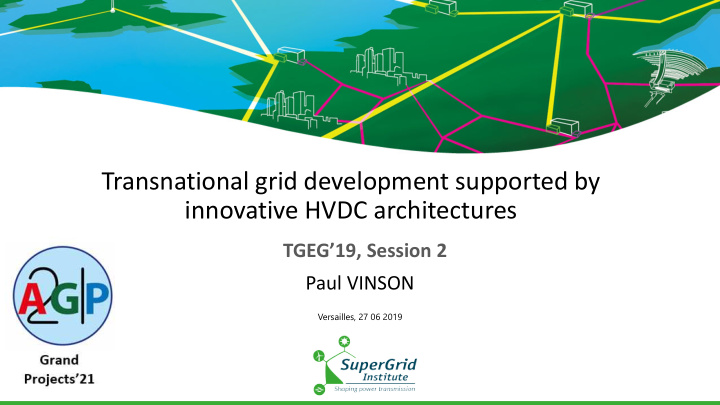



Transnational grid development supported by innovative HVDC architectures TGEG’19, Session 2 Paul VINSON Versailles, 27 06 2019
Content Context & challenges MTDC large power corridors to support electricity highways Subsea nodes : building block for offshore grid development? Conclusions & Perspectives 2
Context & challenges Humanity is facing 3 major challenges: Keep global warming “well below” 2 ° C Reduce air pollution Provide everyone access to secured energy https://www.statista.com/chart/9656/the-state-of-the-paris-agreement/ Electricity is central in our lives. The sector is shaken by 3 majors trends: Decarbonisation: rush on renewables sources, greater electrification (e.g mobility) Digitalisation: increased use of data and communication for optimized management Decentralisation: distributed energy sources, storage, new uses and markets Transmission electricity grids have the opportunity to reinvent and serve the energy transition
Global Electricity Grids At world level, studies highlighted the benefit of having a strong, interconnected electricity network providing : • Greater energy access • Lower prices for consumers • Decarbonisation trough larger use and better integration of renewables https://spectrum.ieee.org/energy/the-smarter-grid/lets-build-a-global-power-grid
Global Electricity Grids On European scene : Strong policies and support to key R&I projects from the E.U. Dives into countries realities Explore the benefits and pave the Highlights reinforcements way for offshore grid extensions Grid reinforcements and extensions are needed Europe may be the birthplace of a future global electricity grid
Reinforcements options : HVDC large power corridors Today, mainly cross border interconnectors Rely on national grid transmission capability? With some local AC grid reinforcements? How far national grids can support high additional transmission requirements? To implement cross-border and inland electricity highways HVDC is a competitive option ( e.g. illustrated by the German choices)
Building large power corridors or Multiple Point to Point Multi Terminal architecture PtP 2GW Full flexibility requires 10 converters Full flexibility requires Converters at both ends 20 converters Converter Capex and Opex (e.g. losses) divided by ~2 : Converter
: Substation : Converter Building large power corridors: Multiple Point to Point Multi terminal architecture P max P max Max power scenario P max P max 200 km 200 km P max P max 50 km P P Availability of P=P max = 94.5% Availability of P=P max = 96% P=0 P=0 Lower power scenario P max P max P max P max P P Availability of P=P max = 94.5% Availability of P=P max = 98.6% Increased availabities trough MTDC architectures
Building large power corridors: Planning Using existing assets HVDC PtP Upgrade OHL AC DC HVDC PtP Building new lines Building adapted power taps Adding lines & taps Region A Region B Region C Region D Extending the Corridor offshore Grid planning & high level architecture principles are key Step wise implementation is possible
Large power corridors: challenges Decision support and Interoperability of Stability issues with HVDC systems tools for grid systems embedded in AC system planning Regulation framework Interoperability of Protection schemes and strategies technologies Upgrading of existing with OHL or hybrid OHL/cables HVAC lines to HVDC New building block Offshore nodes
Offshore nodes: Synergies for OWF and Interconnector Context : • Increase of interconnections Tee-in • Offshore wind is booming • Landfalls place and public acceptance is limiting Using new or existing interconnectors in the vicinity of windfarms shall generate win-win business case Benefits of Tee-in connection: • Mutualize costs • Rationalized offshore grid & connection points at shore • Increases RES availability • Allows for step-wise and modular development
Offshore nodes : going subsea? Decreasing costs of RES integration ? Bottom fixed platform are feasible in the North and • ? Baltic seas as it is relatively shallow (<60m) But future windfarms will be located in deep water • ? Floating platforms are an option, but: Non negligible impact on sea users • HVDC Dynamic cables are probably too risky to be used on interconnectors • Subsea node is an interesting solution to connect RES to interconnectors
Subsea nodes : challenges Expected requirements >320 kV DC, 3 ways branching unit • Disconnecting capabilities • Remote control & monitoring • Installable and protectable at reasonable cost • Maintenance free • Photo: IEEE Spectrum State of art and technological gap Oil & Gas take advantage of 36kV subsea nodes (AC) • HVDC extruded cable system is a mature technology • HVDC GIS have been long-term tested • HV bricks are available to foresee a subsea HVDC node Challenges are on sea watertightness, power supply and marine installation
Conclusions Global electricity grids are expected to bring large societal benefits Regulatory and technological challenges remain but projects/initiatives are pushing Europe can be a central place for the development of such grids HVDC MTDC is a good option to support its growth Planning is crucial : stepwise but coordinated with a long term strategic vision Offshore assets are key towards a global electricity grid for energy transition Subsea node would ease a step-wise and modular development
An Independent R&I center, developing Key technologies for the future electricity grids Institute for Energy Transition (ITE) Private company federating academics and industrials Created trough the french investment program Lyon (Villeurbanne), France Launched in 2014, 170 researchers and 55 patents Unique test platforms High value technologies and services for own prototyping and : third parties testing Increased energy efficiency Massive RES integration Hyperbaric test vessel for combined testing 15
Transnational grid development supported by innovative HVDC architectures Thank you for your attention Paul VINSON Technical Strategy Dept. paul.vinson@supergrid-institute.com Tel : +33 6 80 87 13 17
Recommend
More recommend